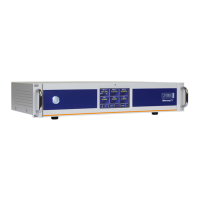MercuryiTC
©2014 Oxford Instruments Omicron NanoScience. All rights reserved.
Page 38
• Using a generic calibration file (if applicable) + generic sensor adjustment
• More about thermocouples
See chapter 9 for a description of the temperature sensor circuit and chapter 10 for a
description of the heater circuit.
4.1 Heater and sensor connections
The temperature sensor input and heater output are connected via the 9-way D-connector on
the rear panel of the iTC.
Pin number Connection Male plug (cable)
1
Sensor input high
2
Sensor input screen.
3
Sensor input low
4
Current source +ve
5
Current source -ve
6
Heater output +ve
7
Heater output -ve
8
Connected to pin 3
9
Chassis ground.
Connections to the sensor vary depending on the type of sensor in use, as summarized in the
next table.
Connection Thermocouple Metal resistor
Ge/C resistor Si/GaAs diode
Sensor Input High V+ V+ V- V+
Sensor Input Low V- V- V+ V-
Current source +ve
Connect pins 3,4,5
together
I+ I+ I+
Current source -ve
Connect pins 3,4,5
together
I- I- I-
4.1.1 Connecting thermocouples
Thermocouples must be connected using the correct wire type to ensure accurate
measurements.
Stability of the measurement is improved by biasing thermocouples above the ground plane of
the iTC. This is achieved by connecting together pins 3, 4 and 5 of the 9 way D connector (see
table above). Biasing the thermocouple in this way prevents error currents flowing in the

